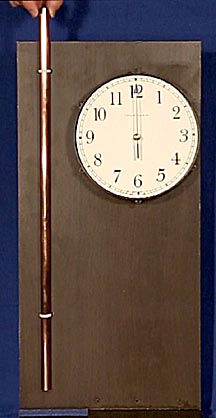
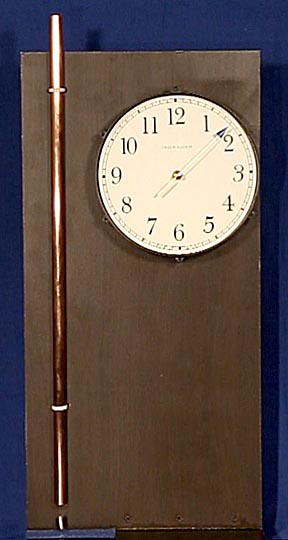



Drop a powerful neodymium magnet down a copper pipe and rather than plummeting downward, in defiance of expectations it slowly drifts down with almost painful grace. This popular demonstration of magnetic damping and the power of eddy currents comes to us thanks to Lenz's Law.
Lenz's Law states that anytime a magnet moves near a conductor, a current will be induced to flow in the conductor and that this current will follow a path that will create a second magnetic field oriented to resist changes in the original magnetic field. If the magnetic field strength is increasing, the current will flow in a way that will produce a magnetic field opposed to the first magnetic field in an attempt to cancel its increasing flux. If the magnetic field is decreasing, the current will flow in the opposite direction so that its associated magnetic field reinforces the first magnetic field in an attempt to prevent it from decreasing.
In the case of a magnet falling down through a conducting, but non-magnetic, tube, the tube initially experiences a field that is increasing in strength.
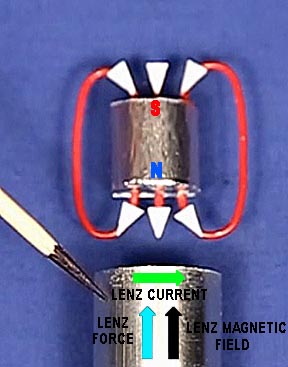
From Lenz's Law, we know that a current will be induced to flow in the tube to create a field that will try to cancel the magnet's increasing magnetic field. Using the right hand rule, if we point the thumb of our right hand in the direction of the opposing or Lenz's magnetic filed, up in this case, the fingers of that hand will curl around in the direction of the current, or left to right over the tube. Because like fields repel, the same as trying to push the north poles to two magnets together, the secondary, or Lenz field, will push push against the magnet.
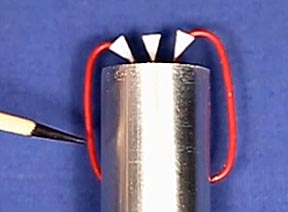
Because the magnetic field lines are mostly straight along the sides of the magnet, the field strength is constant. In this zone the tube doesn't see a changing field so the current falls to almost zero.
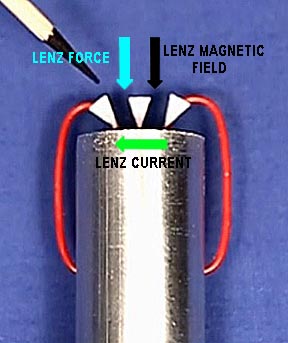
But, as the rear end of the magnet sweeps through the same zone, the magnetic field starts converging on the south pole and the tube experiences a decrease in field strength. Lenz's Law states that in this case a current will be induced that will create a magnetic field that will try to strengthen the decreasing field. In this case that means that the induced field will point downward in the same direction as the magnet's field. Since this induced field is pointing down, which is the direction for a magnetic north pole and since opposite poles attract, the falling magnet's south pole experiences an upward pull. Employing the right hand rule in this case tells us that near the end of the falling magnet the current is flowing in the opposite direction, from right to left.
So the falling magnet induces two currents: one rotating left to right around the lower end and one rotating right to left around the upper end. The lower current creates a magnetic push upward with the upper current creates a magnetic pull upward. These two forces combine to slow the magnet down. It does, but there are two problems.
1. This description implies that the induced currents and their associated magnetic fields cancel part of the gravitational force pulling the magnet downward. They do, but it's more dynamic than that. If they just cancelled part of the gravitational force, there'd still be a net downward force on the magnet. If that was the case the magnet would continue to accelerate as it fell down through the copper tube. That doesn't happen. Instead the magnet almost instantly achieves a fixed velocity and remains there for its entire trip down the tube.
What's happening is that on an almost quantum level the magnet oscillates through a series of accelerations and decelerations. Most of the gravity has be counteracted but enough force remains to accelerate the magnet. As soon as it does, its increased velocity increases the time rate of change of the magnetic field, this increase causes more current to be induced in the tube, which in turn increases the magnetic field and associated upward push so the magnet is forced to slow down, If the opposite happens, perhaps as an air current flows up through the tube, the magnet slows, the induced fields diminish and the magnet accelerates back to its terminal velocity once again.
Lenz's Law sounds static, but in fact it's dynamic, always changing to maintain equilibrium.
2. The second
problem is best seen by looking down as the magnet is falling down
through the copper tube.
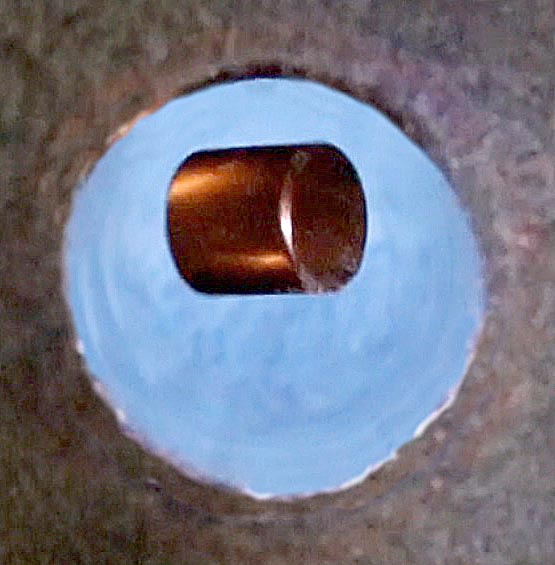
Unless the tube is very small, the magnet doesn't glide smoothly downward but turns and tumbles in slow motion. As it does the orientation of its magnetic field is rotating and shifting in every imaginable direction. The simplistic explanation of the first example doesn't seem to apply anymore. Yet the magnet continues to fall with the same graceful slowness it did when constrained to remain aligned with the tube.
The reason is that at the simplest level Lenz's Law doesn't care about the orientation of the magnetic fields, just whether they are increasing or decreasing.
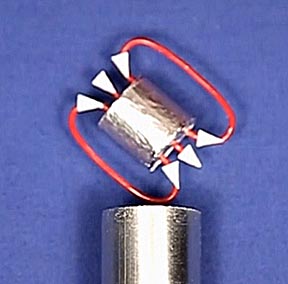
Regardless of how the magnetic is falling, the bottom, or leading, edge will always project an increasing magnetic field. This results in an opposing upward field slowing it down. Similarly, the upper, or top, edge will always project a decreasing field so the induced field will always pull up on the magnet.
What makes this possible is that the induced currents don't always go around the perimeter of the tube in neat circles. They can follow whatever paths are required to produced any magnetic field required. Some of these currents don't even go all the way around the tube, but instead spin in pairs of small circles in one area on one side of the tube. There can also be many different currents following different paths. Collectively, these complex currents are referred to as eddy currents.

Another interesting observation that can be made by looking down as the magnet falls through a copper pipe is that it tends to remain in the center of the tube. The reason is that the Lorentz Rule states that anytime there is a current flowing near a magnetic field, the object producing the magnetic field will experience a force that is perpendicular to both the current and magnetic field, as determined by yet another right hand rule. In this case the force points inward and comes from all the way around the tube, so it tends to keep the magnet in the centered.
By convention,
all these induced currents are considered to be in the direction of
positive current flow. In reality it's negatively charged electrons
that are moving. If you want to know in which direction they are
flowing, use your left hand instead of right. The convention of
positive current flow comes from Benjamin Franklin, who thought
current carriers were positively charged. By the time the mistake was
discovered, the use of right hand rules and positive current flow had
become so intrenched in physics culture the professors decided to
leave things as they were.
Personally, I believe two other forces were at work. The first was intellectual elitism. The people in-the-know embraced the concept because it made it harder for the average Joe to understand. The second is that since most people are right handed so maintaining right hand rules was attractive.
An easy way to feel Lenz forces resulting from eddy currents is to quickly move a magnet over the face of a copper bar.

It'll feel viscous, like you're trying to push it through honey. This is the result of eddy currents resisting the changing magnetic field being created by moving the magnet. Move it faster and the field will change faster and you'll be able to feel a greater force or viscosity. Move it very slowly and there will be no detectable force.
How Lenz's
force works can be partly deciphered by the following experiment in
which fall times of different stacks of magnets are compared. In the
first example, the 8-second fall time was for a single magnet. Two
magnets take only 5-seconds, three take 3.5 and a stack of four
magnets falls in only 3-seconds.
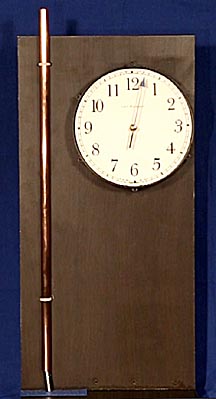
The reason the fall times decrease as the number of magnets increases is that as previously mentioned, field lines along the sides of the magnets are fairly straight and as such do not impose a changing magnetic field on the tube. Therefore the Lenz current and its associated magnetic field are zero. Therefore increasing the number of magnets doesn't change the strength of the magnetic field enough to overcome the increase in gravitational force caused by their greater weight.
Another
interesting experiment is to see what effect changing the diameter of
the copper tubes has on fall times. In the first case, the tube had
an inside diameter of 9/16-inch and the magnet was 1/2-inch in
diameter. Let's see what happens when we switch to a 5/8-inch
diameter aluminum tube.
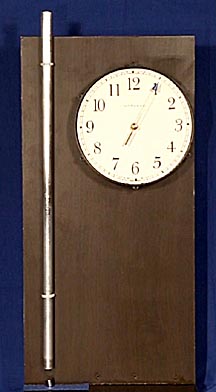
The magnet fall in five seconds. There are two reasons. First, the tube is larger so the walls are further away from the magnet, which reduces the strength of the field. Less field strength means the induced current is smaller and the resulting magnetic field with its upward force is also smaller. Additionally, Aluminum has 40-percent lower conductivity than copper. This results in greater resistance, which in turn limits the current. Going on to a 3/4-inch copper tube results in a 3-second fall time.
The issue of conductivity can be explored by testing tubes of different wall thickness. In this next experiment, the smallest copper tube was placed inside the aluminum tube and that pair inside the large copper tube. While the gaps between the tubes are less than ideal, nonetheless the tubes simulate a thicker walled tube.
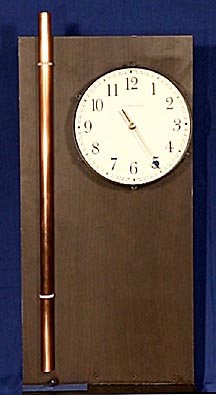
The result is that it takes the same magnet 16.5-seconds to fall down through the tubes.
I repeated this experiment after wrapping two layers of 18-gauge bare copper wire around the small copper tube then placed that unit inside the larger copper tube. The fit was so tight that all together it came close to simulating a solid copper wall thickness of 3/16ths to 1/4-inch. It took the magnet 25 seconds to fall the same 24 inches. So, for the greatest effect use the thickest copper tubing you can find.
An interesting side note about conductivity is that when superconductors, which have zero electrical resistance, are used, once the magnet enters the tube the zero resistance allows the current to build up to such a high level that the magnet completely stops. Since there is no resistance to cause the current to decrease once movement has stopped, the current level remains high enough on its own even without a changing magnetic field that the magnet will float in the tube as long as the tube's superconductivity is maintained.
One last test
is to compare how magnets of different strengths affect fall times.
Neodymium magnets are rated from N35 to N52. The higher the number the greater the field strength. The first test with the 8-second drop time used an N52 magnet. Stepping down to an N48 reduces the drop time to 7-seconds. This 12-percent increase in drop speed is a close match to the approximately 10-percent decrease in magnetic field strength.
While all of this is interesting, it has to be acknowledged that because the magnets are hidden inside copper tubes as they fall, the entertainment value fades quickly. Fortunately, there is an easy solution. Mount two copper bars parallel to each other and slightly farther apart than the distance between the poles of the magnet. Drop the magnet between them with its poles facing the bars and you'll be able to watch it drift slowly downward.

In the image above, the bars were 3/8ths-inch thick and 1-inch wide. The same N52 1/2 x 1/2-inch magnet used in all of the other tests took 14 seconds to fall 18-inches. That equates to 23-seconds for a 24-inch drop.
Applying Lenz's Law to magnets falling down through copper tubes or pipes is a great science demonstration. I hope this page helps anyone interested in exploring this fascinating phenomenon.
If you'd like
to watch a live action video of all the experiments discussed on this
page, please click on the following link:
Return to my main page to browse 60 other subjects